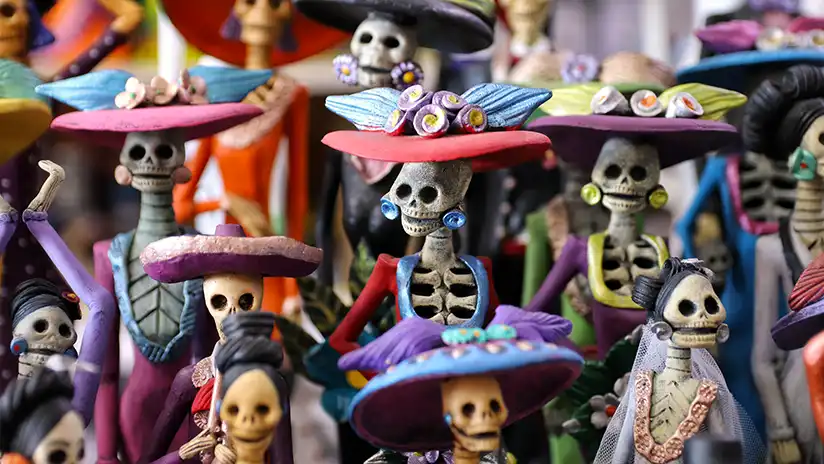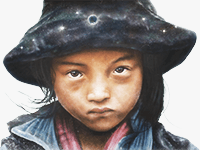The Día de los Muertos
Celebrating the Day of the Dead
The Day of the Dead in Mexico
The Day of the Dead, called “Día de Muertos” (or Día de los Muertos) in Mexico, is one of the most important holidays of the year throughout the country.
On November 1 and 2, the deceased are commemorated, which corresponds to All Souls’ Day and All Saints’ Day and is more of a sad occasion there. In Mexico, however, these days are celebrated quite differently. At the latest since the famous Disney animated film “Coco“, people know that this is more of a joyous occasion.
The Origin of Día de los Muertos
This celebration has its origins even before the colonization by the Spanish. Several of the indigenous cultures of that time believed that death did not mean the final absence of a fellow human being, but also his living presence. Therefore, centuries ago, people in Central America celebrated the Day of the Dead to commemorate the deceased. It is believed that on these days their souls are allowed to come to the world of the living to visit them. For this reason, altars are erected in their honor, decorated and decorated with personal items from the daily life of the deceased.
Tradition and Schedule of the Celebration
The celebrations begin on the evening of October 31, which coincides with the Halloween festival, which actually originated in the United States and has also found favor in Mexico. On November 1, All Saints’ Day, children who died early are commemorated, and on November 2, adults. On this day, many Mexicans go to the cemeteries, where altars decorated with flowers are built on the tombstones. They are supposed to help guide souls to a good path after they die.

Altars (ofrendas) are also set up in homes, apartments and public places, decorated with photos of the deceased, orange blossoms of student flowers (cempasúchil = flower of the dead), palm leaves and with silhouettes of colored tissue paper (papel picado). In addition, white candles, a cross and small colorfully painted skulls (so-called Calaveritas).

The bread of the dead (Pan de Muerto), various fruits and chocolate are supposed to provide for the physical well-being of the returned deceased. And depending on the preferences he or she had, their favorite foods and drinks or even cigarettes can be found on the altar.

A special food prepared on the Yucatán Peninsula only on the Day of the Dead is the so-called El Pip (also Mucbipollo). A pib is a large tamale made of corn dough with black beans, stuffed with chicken and pork, chilies and spices, and slowly cooked in banana leaves in an underground oven (piíb).
In each state of Mexico, Día de Muertos is celebrated somewhat differently, as customs and traditions have developed differently depending on the region. For example, in the major tourist centers around Cancún, in Xcaret Park near Playa del Carmen or on the island of Cozumel, there are often day-long festivals with theater performances, exhibitions, folkloric dances, workshops, crafts and much more. In other places, like Holbox, things are more authentic and a little less touristy.
The Symbol of the Day of the Dead: The Figure of “La Catrina”
At the beginning of the 20th century, the now world-famous effigy of the skeleton lady with the large flower-adorned hat became the most important symbol of Dia de Muertos in Mexico under the name La Catrina. The figure probably originates from the Mexican caricaturist José Guadalupe Posada, who wanted to make fun of the Mexican upper class with it. At the latest since the famous painter Diego Rivera took up the motif in 1947 for his mural “Sunday Dreaming in the Alameda”, it has become a true cult.
In addition to the classic figures in different sizes and materials, the skeleton lady can be found on clothing, bags and utensils, as jewelry or tattoos and, more recently, on the mouth-nose protection.

The Día de los Muertos on Isla Holbox
On Holbox Island, the first Día de los Muertos celebrations begin on October 30th in restaurants, bars and pubs as well as at small parties on the beach. During these days, some hotels also offer events dedicated to the theme.
The official program begins in the afternoon of October 31st and has a different theme each year. As has been the tradition for many years, the local community organizes a grand parade with many people dressed as La Catrina.

Starting from the meeting point at the port near the ferries, the participants and spectators march to the main square, where the most beautiful La Catrina costumes are awarded prizes in the large acoustic dome. Numerous elaborately decorated altars are exhibited in the surrounding park, and the best of which are also awarded prizes in the evening. Finally, there is a folkloric ballet performance, followed by live music and dancing.
And, as is common in Mexico, the party goes on late into the night. Restaurants in Holbox offer special menus, and in numerous bars and nightclubs there is dancing and music with live bands and DJs.


